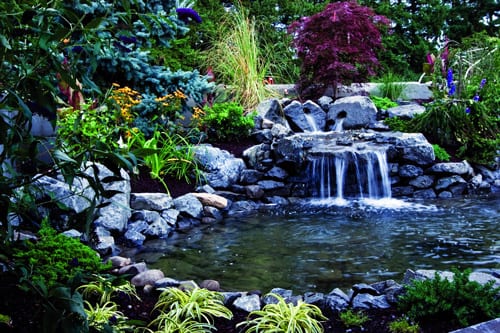
Waterfalls add a sense of beauty and calm to the home’s landscape, with the sound of cascading water adding to the calming effect. There are certain points to consider when installing a waterfall, with many design ideas that will allow the waterfall to complement your home’s landscape. Here’s how you can enjoy the beauty of water outside of the overplayed home swimming pool.
The Benefits of a Waterfall in Your Garden
It adds to your home’s curb appeal. A waterfall is an enhanced landscaping feature for the dedicated homeowner. Not only does it improves the value of the property, but the sound can help drown out noises coming from the road. It adds an appeal to your home, as the waterfall is a prized commodity.
A waterfall can help you do your part for the environment as well. Sustainability has been center stage, and a waterfall can help with that plan. Even though a waterfall will require several gallons to start up, it has a much smaller ecological footprint in the long run.
Once established, your waterfall will quickly become part of the local ecosystem. You can also use a waterfall to house outdoor pets like frogs or even Koi fish.
Designing the Waterfall
There are several factors that you need to weigh in when building a water feature in your yard. Consider if the water is going to flow into an established pond, the amount of water that the waterfall requires to function properly, and how loud you want the waterfall to be, as a higher vantage point will naturally create a noisier water feature.
The waterfall should complement your open spaces and not overwhelm it. Analyze the scale of your yard and house when deciding on the width and length of the waterfall. Thankfully the advent of the Internet exposes the everyday homeowner to different design ideas that can be modified to fit the overall aesthetic of your living spaces.
Considerations
Most waterfalls will use an adjustable dam to regulate the flow of water. Alternatively, you can go the more natural route and make the waterfall using rocks and other hardscapes. The dam used for a waterfall is called a weir, with most using a plastic box that slants at its output. The weir will require a leveled foundation if you have a naturally sloping yard. If your yard is flat, the slope will need to be built with the help of additional soil or holes in the ground. A simple waterfall can easily be constructed with a sloped foundation, a weir, and tubing connecting the pump to the weir.
A more natural looking waterfall without the weir will warrant a sloping foundation. The only additional design factor that you need to consider is the type and placement of the rocks that will complement the rest of your yard. Strategically placed pumps and filters will elevate your waterfall and make it look like an endless loop of water from a source that isn’t so visible to the naked eye.
Designs for Potential Waterfalls
Once the foundation and the appropriate size for your yard have been chosen, then you will be able to use any design of your liking. You can use wood to create a waterfall that is natural and lush, back dropped by a woodland environment or boulder wall. You can also use flat stones to create smaller consecutive waterfalls akin to a stream. If you are short on space, create a makeshift waterfall with a water wall instead. It’s a miniature waterfall that is integrated into a terracotta stone panel.
A waterfall requires professional installation, especially since the sloping gradient must be precise to ensure a low maintenance water feature. Once correctly installed, you have the option of filling the waterfall with fish and truly make it an integrated part of not only your yard, but the local ecological footprint of your neighborhood.
